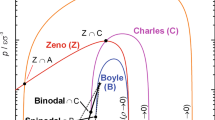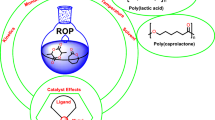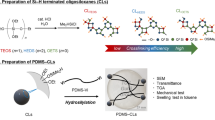Abstract
Four types of polycarboxylate ether (PCE) polymers with consistent backbone length and side-chain (poly(ethylene glycol) monomethyl ether methacrylate MAA-M2000) length but different ratios of acrylic acid (AA) to methacrylic acid (MAA) were synthesized. The ratio of the methyl group would directly affect the backbone stiffness and hydrophobicity of the PCE. Laser light scattering (LLS) and molecular dynamic (MD) simulations were used to investigate the conformations of PCE at various pH values. It was found that the conformation of PCE remained more extended with the decrease of ratio of the backbone methyl group, which resulted in a low exposed extent of carboxylic groups on the backbone at the same ionization degree. The complexation of the carboxylic oxygen atoms of PCE with Ca2+ indicated that the differences of the complexing capacity resulted from the differences in the spatial distribution of carboxylic groups, which depended on the solution conformation of PCE molecules.








Similar content being viewed by others
References
Bergaya F, Lagaly G (2006) General introduction: clays, clay minerals, and clay science. Dev Clay Sci 1:1–18
Hotta Y, Yilmaz H, Shirai T, et al. (2008) State of the dispersant and particle surface during wet-jet milling for preparation of a stable slurry. J Am Ceram Soc 91:1095–1101
Chu LW, Prakash KN, Tsai MT, et al. (2008) Dispersion of nano-sized BaTiO3 powders in nonaqueous suspension with phosphate ester and their applications for MLCC. J Eur Ceram Soc 28:1205–1212
Pringuet A, Pagnoux C, Videcoq A, et al. (2008) Granulating titania powder by colloidal route using polyelectrolytes. Langmuir 24:10702–10708
Kiennemann J, Pagnoux C, Chartier T, et al. (2004) Influence of impurities on dispersion properties of bayer alumina. J Am Ceram Soc 87:2175–2182
Collepardi M (1998) Admixtures used to enhance placing characteristics of concrete. Cem Concr Compos 20:103–112
Kreppelt F, Weibel M, Zampini D, et al. (2002) Influence of solution chemistry on the hydration of polished clinker surfaces-a study of different types of polycarboxylic acid-based admixtures. Cem Concr Res 32:187–198
Lim GG, Hong SS, Kim DS, et al. (1999) Slump loss control of cement paste by adding polycarboxylic type slump-releasing dispersant. Cem Concr Res 29:223–229
Plank J, Bassioni G (2007) Adsorption of carboxylate anions on a CaCO3 surface. Z Naturforsh B 62:1277–1284
Yoshioka K, Sakai E, Daimon M, et al. (1997) Role of steric hindrance in the performance of superplasticizers for concrete. J Am Ceram Soc 80:2667–2671
Yamada K, Takahashi T, Hanehara S, et al. (2000) Effects of the chemical structure on the properties of polycarboxylate-type superplasticizer. Cem Concr Res 30:197–207
Kirby GH, Lewis JA (2004) Comb polymer architecture effects on the rheological property evolution of concentrated cement suspensions. J Am Ceram Soc 87:1643–1652
Ran Q, Somasundaran P, Miao C, et al. (2010) Adsorption mechanism of comb polymer dispersants at the cement/water interface. J Dispers Sci Technol 31:790–798
Dalas F, Nonat A, Pourchet S, et al. (2015) Tailoring the anionic function and the side chains of comb-like superplasticizers to improve their adsorption. Cem Concr Res 67:21–30
Reese J, Plank J (2011) Adsorption of polyelectrolytes on calcium carbonate—which thermodynamic parameters are driving this process? J Am Ceram Soc 94:3515–3522
Madsen F, Peppas NA (1999) Complexation graft copolymer networks: swelling properties, calcium binding and proteolytic enzyme inhibition. Biomaterials 18:1701–1708
Fantinel F, Rieger J, Molnar F, et al. (2004) Complexation of polyacrylates by Ca2+ ions. Time-resolved studies using attenuated total reflectance Fourier transform infrared dialysis spectroscopy. Langmuir 20:2539–2542
Wang X, Ye X, Zhang G (2015) Investigation of pH-induced conformational change and hydration of poly (methacrylic acid) investigated by analytical ultracentrifugation. Soft Matter 11:5381–5388
Wu C, Zhou S (1995) Laser light scattering study of the phase transition of poly (N-isopropylacrylamide) in water. 1. Single chain. Macromolecules 28:8381–8387
Chung YT, Huang CI (2012) Ion condensation behavior and dynamics of water molecules surrounding the sodium poly (methacrylic acid) chain in water: a molecular dynamics study. J Chem Phys 136:124903
Tong K, Song X, Sun S, et al. (2014) Molecular dynamics study of linear and comb-like polyelectrolytes in aqueous solution: effect of Ca2+ ions. Mol Phys 112:2176–2183
Heinz H, Vaia RA, Farmer BL, et al. (2008) Accurate simulation of surfaces and interfaces of face-centered cubic metals using 12-6 and 9-6 Lennard-Jones potentials. J Phys Chem C 112:17281–17290
Laguecir A, Ulrich S, Labille J, et al. (2006) Size and pH effect on electrical and conformational behavior of poly (acrylic acid): simulation and experiment. Eur Polym J 42:1135–1144
Sonnenberg L, Parvole J, Borisov O, et al. (2006) AFM-based single molecule force spectroscopy of end-grafted poly (acrylic acid) monolayers. Macromolecules 39:281–288
Bulo RE, Donadio D, Laio A, et al. (2007) “Site binding” of Ca2+ ions to polyacrylates in water: a molecular dynamics study of coiling and aggregation. Macromolecules 40:3437–3442
Lee H, Boyce JR, Nese A, et al. (2008) pH-induced conformational changes of loosely grafted molecular brushes containing poly (acrylic acid) side chains. Polymer 49:5490–5496
Geffroy C, Foissy A, Persello J, et al. (1999) Surface complexation of calcite by carboxylates in water. J Colloid Interface Sci 211:45–53
Dobrynin AV, Rubinstein M (2005) Theory of polyelectrolytes in solutions and at surfaces. Prog Polym Sci 30:1049–1118
Pergushov DV, Buchhammer HM, Lunkwitz K (1999) Effect of a low-molecular-weight salt on colloidal dispersions of interpolyelectrolyte complexes. Colloid Polym Sci 277:101–107
Zhang G, Wu C (2001) Reentrant coil-to-globule-to-coil transition of a single linear homopolymer chain in a water/methanol mixture. Phys Rev Lett 86:822
Li Y, Huang Q, Shi T, et al. (2006) Effects of chain flexibility on polymer conformation in dilute solution studied by lattice Monte Carlo simulation. J Phys Chem B 110:23502–23506
Xu Z, Hadjichristidis N, Fetters LJ et al (1995) Structure/chain-flexibility relationships of polymers. Physical Properties of Polymers, Springer Berlin Heidelberg, pp 1–50
Choi J, Rubner MF (2005) Influence of the degree of ionization on weak polyelectrolyte multilayer assembly. Macromolecules 38:116–124
Pohlmeier A, Haber-Pohlmeier S (2004) Ionization of short polymethacrylic acid: titration, DLS, and model calculations. J Colloid Interface Sci 273:369–380
Bakshi MS, Sachar S (2004) Surfactant polymer interactions between strongly interacting cationic surfactants and anionic polyelectrolytes from conductivity and turbidity measurements. Colloid Polym Sci 282:993–999
Cametti C, Truzzolillo D (2010) Many facets of the polyelectrolyte and oppositely charged colloidal particle complexation: counterion release and electrical conductivity behavior. J Phys Chem B 115:7248–7255
Manning GS (1969) Limiting laws and counterion condensation in polyelectrolyte solutions I. Colligative properties. J Chem Phys 51:924–933
Fixman M (2010) Electrostatic persistence length. J Phys Chem B 114:3185–3196
Ran Q, Somasundaran P, Miao C, et al. (2009) Effect of the length of the side chains of comb-like copolymer dispersants on dispersion and rheological properties of concentrated cement suspensions. J Colloid Interface Sci 336:624–633
Acknowledgments
This work was supported by the National Natural Science Foundation of China (51408272, 51272100), the Natural Science Fund for Distinguished Youth Scholars (51225801), and the Natural Science Foundation of Jiangsu Province (BK20131013, BK20141012). We are grateful to the High Performance Computing Center of Nanjing University for doing the numerical calculations in this paper on its IBM blade cluster system.
Author information
Authors and Affiliations
Corresponding author
Ethics declarations
Conflict of interest
The authors declare that they have no conflict of interest.
Rights and permissions
About this article
Cite this article
Zhang, Q., Ran, Q., Zhao, H. et al. pH-induced conformational changes of comb-like polycarboxylate investigated by experiment and simulation. Colloid Polym Sci 294, 1705–1715 (2016). https://doi.org/10.1007/s00396-016-3932-5
Received:
Revised:
Accepted:
Published:
Issue Date:
DOI: https://doi.org/10.1007/s00396-016-3932-5




